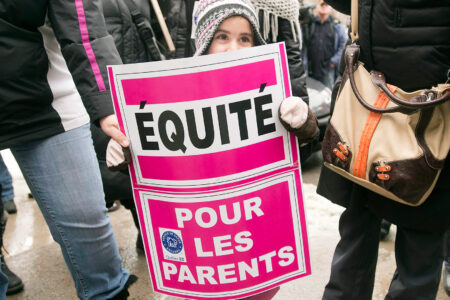
Throughout much of the twentieth century, the framing of inequality in Canada was constructed around an evolving “antipoverty” rhetoric. With the rise of an affluent working class in the years after the Second World War, the mass poverty of the past was apparently eliminated. So attention turned to the minority who could be identified statistically as the “poor.” As Paul Starr notes about discourse in the United States, “So closely was inequality identified with poverty that the two terms were often used as if they were interchangeable.” In Canada, as well, redistributive politics became antipoverty politics, and redistributive policies were constructed within an antipoverty frame.
The antipoverty frame has deep historical roots in the British Poor Law tradition, and carries well-established definitions, causal narratives, normative stances and policy debates. First, it defines the population in need of redistribution as a statistical minority, set apart from the majority who are not impoverished. Second, over the years, this framing has generated a ritualized debate about the causal mechanisms that produce poverty, which tends to polarize around two positions: the bad behaviour of the poor themselves versus misfortune and bad luck often attributed to structural causes. These causal beliefs, in turn, contribute to sharp normative distinctions between the “deserving” poor (widows, orphans, the elderly) and the “undeserving” (young employable adults). Finally, the frame comes loaded with an enduring debate about policy responses between those favouring social programs highly targeted at the poor for efficiency reasons and those favouring more inclusive, universalistic programs for reasons of political effectiveness.
The framing of redistributive policy in continental Europe was rather different. Dating back to Bismarck’s Germany of the 1880s and the papal encyclical Rerum Novarum of 1891, redistributive policy was framed in terms of the “workers’ problem.” The “working class” produced by industrial capitalism was, of course, a much more inclusive slice of the population than the “poor,” and could not easily be ignored. The issue became how to integrate a modern industrial working class increasingly given to supporting socialist political movements. The response was a social insurance welfare state providing “workers” with old age pensions and unemployment and sickness insurance. It was not until the 1980s that the poverty problem (the “socially excluded,” in European parlance) became part of the European debate.
The dominance of the historic antipoverty frame is being challenged by the new, rising inequality, which is accompanied by stable or declining poverty rates.
Canada, like most countries, pursued the social insurance model from the 1940s to the 1970s, introducing unemployment insurance, old age pensions and health insurance. Motivated by the mass dislocation of the 1930s and guided by the Marsh report (1943) and similar blueprints, the postwar generation built a social infrastructure designed to meet the needs not just of the “poor” but of Canadians generally. To be sure, these general programs helped the poorest most, redistributing resources and life chances down the income scale, but that was not their primary purpose. The social role of the state was also to protect the incomes of the population as a whole, and to help Canadians meet their health care and education needs. Not surprisingly, perhaps, these programs also came to be seen as instruments of territorial integration, knitting together a vast country otherwise divided by language and region.
It did not take long, however, for Canadian discourse to gravitate back to a focus on the poor. In the late 1960s, Canada “rediscovered poverty.” Statistics Canada introduced a new measure of “poverty,” the low-income cut-off (LICO), which policy agencies and activists have monitored carefully ever since. Every surge in the LICO was the occasion for demands for a new political offensive by antipoverty and other groups that claimed to speak for the disadvantaged. Government departments concerned with the elderly, children, the disabled and lone parents routinely monitored LICO rates among their client populations. This trajectory peaked in 1989, when Parliament unanimously adopted a motion committing Canada to abolish child poverty by the year 2000.
Policy followed. In the 1970s, the federal and provincial governments launched the Social Security Review, which debated a major restructuring of social programs to target benefits more tightly at the poor. In the 1980s, the Macdonald Royal Commission on the economy added its voice, recommending a sweeping move away from universal transfer programs to a single, integrated, income-tested benefit. Such proposals for radical restructuring failed. But the antipoverty focus guided incremental change in the decades that followed, a process perhaps best symbolized at the federal level by the long, slow evolution from universal family allowances to income-targeted child benefits. Policy design in this period was guided by what is known as the “negative income tax” (NIT) model, sometimes referred to as a guaranteed income. A similar pattern prevailed in all the Anglo-Saxon countries; the Earned Income Tax Credit in the United States, the Family Tax Credit in Australia, the Child Tax Credit in the United Kingdom and, in Canada, the National Child Benefit and, most recently, the Working Income Tax Benefit are examples.
In recent decades, Canada updated its poverty frame by embracing the European metaphor of “social inclusion.” Here the focus was less on the poor generally and more on groups that face multiple barriers to entry into the mainstream of society, especially into the labour force: newly arrived immigrants, single mothers, Aboriginal peoples, people with disabilities. This discourse highlighted the needs of excluded groups, but remained firmly within an antipoverty framework. The primary indicator of exclusion was a long-term poverty rate considerably higher than among the population as a whole, and the discourse implicitly deflected attention away from inequality among full-time workers in the paid labour force.
The dominance of the historic antipoverty frame, however, is being challenged by the new, rising inequality, which is accompanied by stable or declining poverty rates, depending on how it is measured. The rich are getting richer, but the poor are not getting poorer. To be sure, the “poverty problem” has not gone away. Canada continues to tolerate poverty rates well above international norms, and there are many who insist that policy-makers should still give priority to the problems of the poor and the socially excluded. Yet a primary focus on poverty no longer fully captures the strains generated by rising inequality. In effect, the antipoverty frame and the policy tools it has generated have run out of political gas. The unbalanced growth of Canadian incomes in recent decades has created an opening for alternative, competing frames.
Photo: Shutterstock
Excerpted from “The Politics of Income Redistribution in Canada” (available online at irpp.org), which will be published in Income Inequality: The Canadian Story, edited by David A. Green, W. Craig Riddell and France St-Hilaire (Montreal: Institute for Research on Public Policy, forthcoming).






